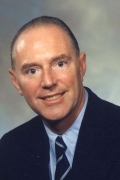Academy of Distinguished Alumni

Harry Bolton Seed Ph.D., N.A.E., N.A.S.
Inducted to the Academy of Distinguished Alumni as an Honorary Member on
Harry Seed was born in Bolton, England in 1922. He received his B.Sc. degree in Civil Engineering in 1944 and Ph.D. in Structural Engineering in 1947, both from Kings College, University of London. Following graduation, Professor Seed traveled to Harvard University to study soil mechanics under Karl Terzaghi and Arthur Casagrande. He received an S.M. degree from Harvard in 1948, spending the next year as an instructor there. He joined the civil engineering faculty at Berkeley in 1950 and he remained on the faculty the rest of his life. He was the Edward G. and John R. Cahill Professor at the time of his death in August 1989. At Berkeley, Professor Seed was the “father” of the Berkeley geotechnical program, bringing together outstanding faculty who collaborated to develop a geotechnical program of both national and world prominence. He served as the Civil Engineering Department Chair from 1965 to 1971, a period during which the department received top national ranking for its quality.
In the early 1960’s, Professor Seed began to develop the new field of geotechnical earthquake engineering, and he is recognized world-wide for his seminal work in this field. With his students and colleagues, he pioneered methods for analysis of seismic site response, soil-structure interaction, seismic slope stability, and liquefaction potential. This work, founded on sound scientific principles, was adopted throughout the world for earthquake resistant design of earth dams, power plants, coastal facilities, and building foundations. Professor Seed’s investigations of major disasters, such as the 1964 Great Alaska earthquake, 1971 San Fernando earthquake, 1976 Teton Dam failure, 1979 Port of Nice landslide, and 1985 Mexico City earthquake, elucidated the causes of these events and the measures that must be taken to prevent similar occurrences in the future. His selection by the government of Egypt to conduct a seismic safety evaluation of the Aswan High Dam placed the safety of literally millions of people in his hands.
Professor Seed received numerous awards and honors during his career. He was an excellent lecturer and teacher and received Berkeley’s Distinguished Teaching Award in 1976. He was elected to the National Academy of Engineering (NAE) in 1970 and National Academy of Sciences (NAS) in 1986. He received the National Medal of Science, the nation's highest scientific honor, from President Reagan in 1987. The American Society of Civil Engineers (ASCE) accorded him more awards than any other engineer in the history of the society, including two Norman Medals, three James J. R. Croes Medals, four Thomas A. Middlebrooks Awards, the Thomas Fitch Rowland Prize, Wellington Prize, Walter A. Huber Research Prize, and the Karl Terzaghi Award. He also received many international honors including selection as the Rankine Lecturer by the British Geotechnical Society in 1979. He was elected an ASCE Honorary Member in 1985, and an honorary member in the Earthquake Engineering Research Institute in 1988. In 1993, ASCE established the H. Bolton Seed Medal in his honor.
